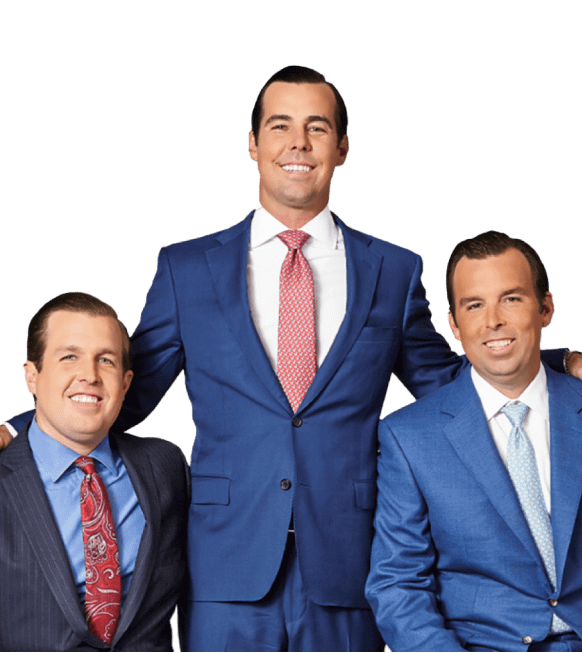What Are Some Examples of Negligence Cases?
What Are Some Examples of Negligence Cases?
Rating Overview
- The Fee Is Free Unless You Win®.
- America's Largest Injury Law Firm™
- Protecting Families Since 1988
- 20 Billion+ Won
- 1,000+ Lawyers Nationwide
Free Case Evaluation

The attorneys featured above are licensed in Florida. For a full list of attorneys in your state please visit our attorney page.
What Are Some Examples of Negligence Cases?
In personal injury cases, the injured party relies on a legal concept called negligence to prove that the other party was at fault for causing them harm. So, what is negligence? In this article, we'll break down the meaning of this legal concept through an illustration of its key components: duty and breach.
The Fundamental Elements of Negligence
When trying to prove that another person’s negligence was the cause of an injury, the first step is to establish that he or she had a duty of care in the situation where the injury occurred. A plaintiff injured by the defendant's negligence needs to provide evidence that a duty of care was breached. In order to successfully win a lawsuit, the plaintiff needs to show that they sustained real injuries from that breach.
It is up to a plaintiff in an injury case to show proof that actions taken by the defendant failed to meet the level of care expected under the circumstances. But what is considered "reasonable" in one situation may be significantly more or less reasonable in another given scenario.
What Does "Duty of Care'' Mean in a Personal Injury Case?
"Duty of care" is a legal obligation to avoid causing harm to others. For example, drivers are legally required to drive with reasonable care and attention, especially when taking into consideration factors such as time of day, weather conditions, and traffic.
State legislatures have enacted traffic laws that identify drivers' obligations when presented with different situations (e.g., in yielding) as well as prohibiting certain actions (texting while driving). If a driver violates a driving law and causes an accident that injures others, he or she would be said to have breached the duty of care owed.
Here are some examples that illustrate the duty of care in other types of injury cases:
- Property owners have a legal obligation to act within a reasonable time when they are made aware of hazards to keep the premises free from known potential dangers and be aware of any new dangers as they present themselves.
- In a medical malpractice case, the health care provider must provide treatment in line with what would be considered "standard of care" for the field, which is often established by medical experts called as witnesses.
- In a defective product case, the company that manufactured and distributed the product has a legal obligation to protect consumers from unreasonable or unexpected dangers in their goods.
Examples of "Breach of Duty” in a Personal Injury Case
Once it has been determined that the defendant owed the plaintiff a duty of care, the next step is for the plaintiff to prove how exactly the defendant's actions were unreasonable. In other words, how does the defendant's act of harming the plaintiff make them legally responsible?
In the case of a car accident, fault can be established in several ways, including:
- In a police report, it may be revealed that the defendant has violated traffic laws.
- Submittingbased eyewitness accounts of the collision
- Through testimony given by the plaintiff
- Using the investigator's examination at the accident scene that included assessing car damage.
In some cases, the defendant's negligence may not be solely responsible for injuries. When it comes to determining fault, if the plaintiff was driving a few miles an hour over the speed limit at the time of the collision, it could be possible that their own negligence played just as much of a role (if not more) than the other driver.
If an injury is at least partly the plaintiff's fault, then his or her compensation will be reduced by their percentage of liability. This is known as comparative fault and is typically the rule of thumb for most personal injury cases in the United States. But there are a few states that use a contributory negligence system, meaning if the plaintiff is found to be at least one percent liable for an accident, they can't recover damages from any other defendants.
Accident Situations That Demonstrate Negligence
The final component needed to establish negligence is proof that the plaintiff has suffered harm from the defendant’s actions (or lack thereof).
Examples of Negligence:
Negligence cases in personal injury law can manifest in a number of ways. Below are a few examples of what they might look like:
Medical negligence
Medical negligence does not refer to intentional harm, but instead an act of carelessness. Any failure to provide acceptable medical care, or meeting an industry standard for patient care, which results in injury could constitute medical negligence.
- If a patient is not rotated often enough and gets bedsore wounds that become infected
- At any point in time, a nurse or pharmacist could make an error that could injure the patient
- Nursing home abuse and/or neglect
- Abandonment of a patient or vulnerable person by their caregiver
- Not providing nutritious meals, prompt hygiene, or appropriate medical care
- If the staff allowed other residents and visitors to abuse a person
Premises Liability
You have a right to be safe from harm when on other people's property. This can include accidents caused by something unsafe or defective that they found there, or because of the way the premises were managed.
- Falling objects like trees
- Slip and falls
- Defectively designed or poorly maintained stairways
- Inattentive security
- Fire safety and building code violations
- Poor property lighting
- Accidents while shopping at your local supermarket
- Elevator accident
- Dog attacks
- Trip and falls on uneven sidewalks and walkways
Wrongful Death
Wrongful death claims are made against individuals whose actions, whether intentional or negligent in nature, resulted in the death of another. In car accidents, some circumstances that can result in a wrongful death negligence suit includes:
- Drivers can be negligent by commission when they do something they should not, like speeding through a stop sign and causing an accident to their fellow drivers.
- A driver can also be negligent if he fails to do something, like not using headlights while driving at night. This act of omission may result in an avoidable accident and injuries.
If a person acted recklessly or maliciously, the individual may also face criminal charges. Furthermore, the judge could order punitive damages.
Common Defenses to Personal Injury Suits Involving Negligence
When sued for negligence, it is important that defendants find a skilled attorney to help them throughout the process. There are a number of ways an individual can win their case.
Contributory Negligence
The plaintiff contributed to their own injury by being negligent. Perhaps they didn’t take reasonable steps to protect themselves from harm. If both the defendant and plaintiff are negligent, but the plaintiff is more at fault for what happened (more than 50%), then they may not be compensated.
Comparative Negligence
In this scenario, both the plaintiff and defendant contributed to some degree of negligence. The judge then determines for each party what percentage of fault is held overall and grants damages according to the portion caused by the defendant, but reduced by the percentage of fault by the plaintiff.
Assumption of Risk
A defendant in a lawsuit is not always liable for injury to the plaintiff that results from an act or activity that the plaintiff consented to and knew had some degree of risk, assuming there was no coercion. This isn't always a guaranteed outcome as some courts may still find the harm caused is egregious in nature and unreasonable.
How it works
It's easy to get started.
The Fee Is Free™. Only pay if we win.
Results may vary depending on your particular facts and legal circumstances.
Step 1
Submit
your claimWith a free case evaluation, submitting your case is easy with Morgan & Morgan.
Step 2
We take
actionOur dedicated team gets to work investigating your claim.
Step 3
We fight
for youIf we take on the case, our team fights to get you the results you deserve.
FAQ
Get answers to commonly asked questions about our legal services and learn how we may assist you with your case.
How Much Does a Personal Injury Lawyer Cost?
Personal injury attorneys like those at Morgan & Morgan work on a contingency fee system, which means they are only paid if they win the case.
This is an ideal arrangement for plaintiffs. It allows them to be represented by a quality lawyer without having to pay hourly fees upfront.
How Long Do I Have to File My Personal Injury Suit?
Many people miss the deadline for filing a personal injury lawsuit because they are not aware of statutes of limitations. In some states, you have a limited time window—such as a year or two—to file a lawsuit once your accident occurs. Waiting too long can make it more difficult for a personal injury law firm to take your case, and in turn, delay the process of pursuing compensation.
If you are a victim of an injury that has left you unemployable and burdened with medical bills, it is important to contact an attorney as quickly as possible to prevent deadlines from running out.
What Type of Damages Could I Recover for My Personal Injury?
Economic damages and non-economic damages are two different types of compensation for those who have been harmed by an accident.
Certain economic damage settlements are paid to cover specific monetary costs, which can include:
- Current Medical Expenses: The cost may include: emergency room visits, hospital stays, surgery fees, the expense of assistive devices, and appointments with treating physicians.
- Future Medical Expenses: Compensation for ongoing medical care and treatment associated with your injuries.
- Lost Wages: Compensation for the time between when you were injured and when the case is concluded.
- Loss of Earning Capacity: If the victim can demonstrate their ability to earn a living has been significantly hurt by the accident, compensation may be available. The awarding party will look at how much income the victim could have earned had they not been involved in an accident and award them that amount.
Non-economic damages compensate victims and their families for losses that can't be calculated in dollars, such as:
- Pain and Suffering: In a personal injury claim, pain and suffering is compensated with the intent of measuring how long it will take for the victim to fully recover.
- Mental Anguish: Damages for emotional pain stemming an accident, including fear, embarrassment, anxiety, worry, and grief.
- Loss of Consortium: A spouse, parents, and minor children may be entitled to compensation for the loss of services, assistance, help, and company from a loved one injured in an accident involving negligence.
It is not uncommon for a plaintiff to seek punitive damages when the defendant’s actions were willful, malicious, fraudulent, or reckless. These types of damages are meant as a punishment against the person and an attempt to prevent similar behavior in the future.
Don't Fight the Insurance Company Alone, Call Morgan & Morgan
Injuries sustained from a fall are often debilitating, and with such injuries comes the need for long-term care. If you or someone you know was injured as a result of a slip and fall accident, our law firm can help ease the burdens you are facing during this difficult time.
Morgan & Morgan offers a contingency fee basis because we know you are in a time of need. Everyone deserves access to top-quality legal services after being hurt by another's negligence, no matter their circumstance.
At Morgan and Morgan, our team of personal injury lawyers is here to help you. We know that this experience may be difficult for you and your family. If you have any questions or concerns we are able to speak with you about them anytime. With over $9 billion in settlements and verdict awards, our firm has proven our dedication to maximizing compensation for our clients and getting them that new beginning.
When you want the best attorneys for your injury claim, just reach out to Morgan & Morgan. Please fill out our brief contact form to find out more about our free consultation offer.






